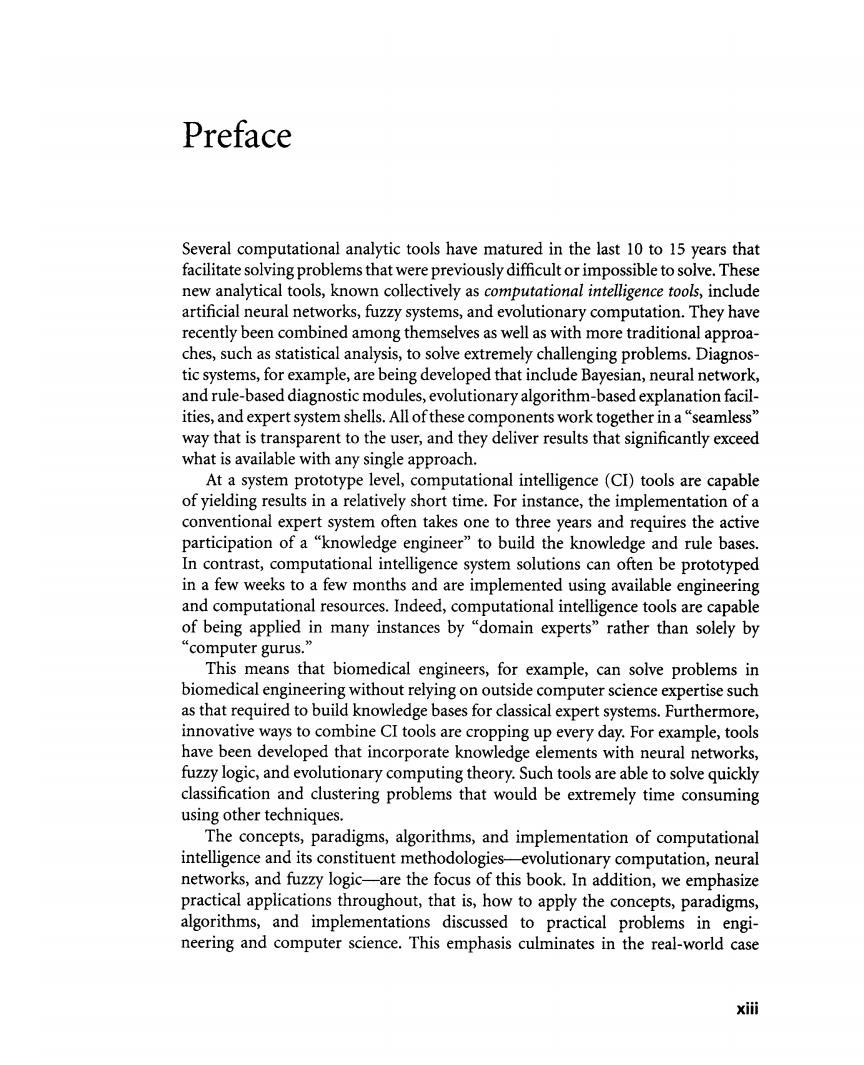正在加载图片...

Preface Several computational analytic tools have matured in the last 10 to 15 years that facilitate solving problems that were previously difficult or impossible to solve.These new analytical tools,known collectively as computational intelligence tools,include artificial neural networks,fuzzy systems,and evolutionary computation.They have recently been combined among themselves as well as with more traditional approa- ches,such as statistical analysis,to solve extremely challenging problems.Diagnos- tic systems,for example,are being developed that include Bayesian,neural network, and rule-based diagnostic modules,evolutionary algorithm-based explanation facil- ities,and expert system shells.All of these components work together in a"seamless" way that is transparent to the user,and they deliver results that significantly exceed what is available with any single approach. At a system prototype level,computational intelligence(CI)tools are capable of yielding results in a relatively short time.For instance,the implementation of a conventional expert system often takes one to three years and requires the active participation of a "knowledge engineer"to build the knowledge and rule bases. In contrast,computational intelligence system solutions can often be prototyped in a few weeks to a few months and are implemented using available engineering and computational resources.Indeed,computational intelligence tools are capable of being applied in many instances by "domain experts"rather than solely by “computer gurus.” This means that biomedical engineers,for example,can solve problems in biomedical engineering without relying on outside computer science expertise such as that required to build knowledge bases for classical expert systems.Furthermore, innovative ways to combine CI tools are cropping up every day.For example,tools have been developed that incorporate knowledge elements with neural networks, fuzzy logic,and evolutionary computing theory.Such tools are able to solve quickly classification and clustering problems that would be extremely time consuming using other techniques. The concepts,paradigms,algorithms,and implementation of computational intelligence and its constituent methodologies-evolutionary computation,neural networks,and fuzzy logic-are the focus of this book.In addition,we emphasize practical applications throughout,that is,how to apply the concepts,paradigms, algorithms,and implementations discussed to practical problems in engi- neering and computer science.This emphasis culminates in the real-world case xiiiPreface Several computational analytic tools have matured in the last 10 to 15 years that facilitate solving problems that were previously difficult or impossible to solve. These new analytical tools, known collectively as computational intelligence tools, include artificial neural networks, fuzzy systems, and evolutionary computation. They have recently been combined among themselves as well as with more traditional approaches, such as statistical analysis, to solve extremely challenging problems. Diagnostic systems, for example, are being developed that include Bayesian, neural network, and rule-based diagnostic modules, evolutionary algorithm-based explanation facilities, and expert system shells. All of these components work together in a "seamless" way that is transparent to the user, and they deliver results that significantly exceed what is available with any single approach. At a system prototype level, computational intelligence (CI) tools are capable of yielding results in a relatively short time. For instance, the implementation of a conventional expert system often takes one to three years and requires the active participation of a "knowledge engineer" to build the knowledge and rule bases. In contrast, computational intelligence system solutions can often be prototyped in a few weeks to a few months and are implemented using available engineering and computational resources. Indeed, computational intelligence tools are capable of being applied in many instances by "domain experts" rather than solely by "computer gurus." This means that biomedical engineers, for example, can solve problems in biomedical engineering without relying on outside computer science expertise such as that required to build knowledge bases for classical expert systems. Furthermore, innovative ways to combine CI tools are cropping up every day. For example, tools have been developed that incorporate knowledge elements with neural networks, fuzzy logic, and evolutionary computing theory. Such tools are able to solve quickly classification and clustering problems that would be extremely time consuming using other techniques. The concepts, paradigms, algorithms, and implementation of computational intelligence and its constituent methodologies~evolutionary computation, neural networks, and fuzzy logic~are the focus of this book. In addition, we emphasize practical applications throughout, that is, how to apply the concepts, paradigms, algorithms, and implementations discussed to practical problems in engineering and computer science. This emphasis culminates in the real-world case imm XIII